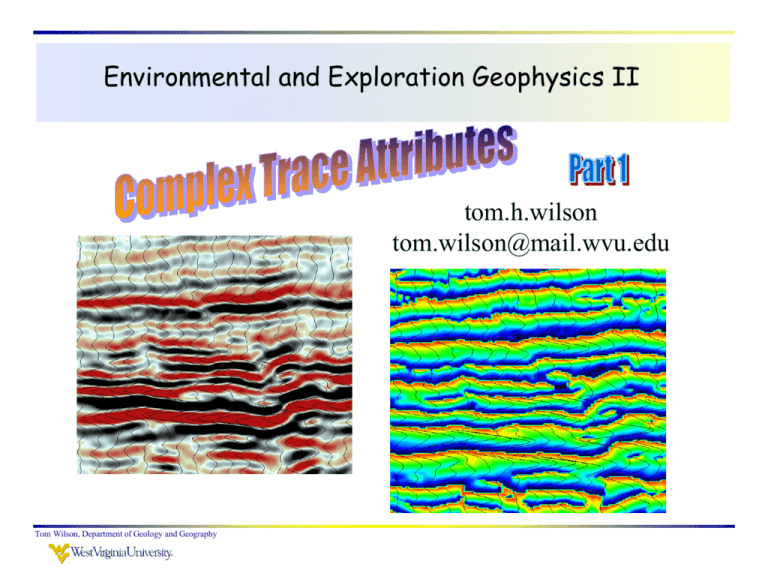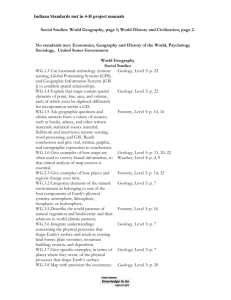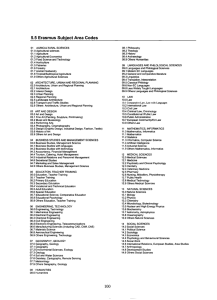Mathematical operation used to compute the synthetic seismogram
advertisement

Environmental and Exploration Geophysics II tom.h.wilson tom.wilson@mail.wvu.edu Tom Wilson, Department of Geology and Geography Mathematical operation used to compute the synthetic seismogram C (t ) a( )b(t )d The convolution integral Seismic Analog S (t ) w( )r (t )d where S is the seismic signal or trace, w is the seismic wavelet, and r is the reflectivity sequence Tom Wilson, Department of Geology and Geography Physical nature of the seismic response Tom Wilson, Department of Geology and Geography Convolutional model S (t ) w( )r (t )d The output is a superposition of reflections from all acoustic interfaces and the convolution integral is a statement of the superposition principle. Tom Wilson, Department of Geology and Geography Discrete form of the Convolution Integral t St w rt 0 As defined by this equation, the process of convolution consists of 4 simple mathematical operations 1) Folding 2) Shifting 3) Multiplication 4) Summation Tom Wilson, Department of Geology and Geography Complex numbers Tom Wilson, Department of Geology and Geography Tom Wilson, Department of Geology and Geography Given the in-phase and quadrature components, it is easy to calculate the amplitude and phase or vice versa. Tom Wilson, Department of Geology and Geography The seismic trace is the “real” or in-phase component of the complex trace How do we find the quadrature component? Tom Wilson, Department of Geology and Geography In the time domain the Hilbert Transform consists of a series of values that are asymmetrical in shape: positive to one side and negative to the other. Values in the series are located at odd sample points relative to the middle of the series and diminish in magnitude with odd divisors: 1,3,5, etc. Tom Wilson, Department of Geology and Geography Tanner, Koehler, and Sheriff, 1979 View of Hilbert transform operator in relation to the samples in a seismic trace From Marfurt, 2006, SEG Short Course Tom Wilson, Department of Geology and Geography Tom Wilson, Department of Geology and Geography Recall Frequency Domain versus Time Domain Relationships Tom Wilson, Department of Geology and Geography Amplitude spectrum Fourier Transform of a time series Phase spectrum Individual frequency components Time-domain wavelets Tom Wilson, Department of Geology and Geography Zero Phase Minimum Phase Seismic Trace 6000 4000 Amplitude The seismic response is a “real” time series 2000 0 -2000 -4000 -6000 0.0 0.5 1.0 1.5 2.0 2.5 3.0 3.5 4.0 Time (seconds) Amplitude Spectrum This is its amplitude spectrum Amplitude 16000 12000 8000 4000 0 0 50 100 150 Frequency Tom Wilson, Department of Geology and Geography 200 250 The Fourier Transform of a real function, like a seismic trace, is complex, i.e., it has real and imaginary parts. Real Part of the Fourier Transform 5 2x10 The real part is even Amplitude 5 2x10 5 1x10 Symmetrical 4 5x10 0 4 -5x10 5 -1x10 -2x10 5 -20 -15 -10 -5 0 5 10 15 20 Frequency (Hz) Imaginary Part of the Fourier Transform 5 2x10 5 Asymmetrical 1x10 Amplitude The imaginary part is odd 4 5x10 0 -5x10 -1x10 -2x10 4 5 5 -20 -15 -10 -5 0 5 Frequency (Hz) Tom Wilson, Department of Geology and Geography 10 15 20 Real Part Amplitude 1000 Line 49, CrossLine 30 500 0 150 Spectrum -500 100 100 Amplitude Amplitude -1000 50 0 80 -1500 -100 60 -50 0 50 100 Frequency 40 -50 20 Imaginary Part -100 0 0.8 1.0 1.2 1.4 Time (sec) Seismic response of the channel 1.6 -50 0 50 100 Frequency (Hz) Amplitude -100 -150 2000 1500 1000 500 0 -500 -1000 -1500 -2000 -100 -50 0 Frequency (Hz) Tom Wilson, Department of Geology and Geography 50 100 Line 49, CrossLine 30 150 Amplitude 100 50 0 -50 -100 -150 0.8 1.0 1.2 Time (sec) Tom Wilson, Department of Geology and Geography 1.4 1.6 Tom Wilson, Department of Geology and Geography Tom Wilson, Department of Geology and Geography Computer exercise: generating attributes and evaluating their ability to enhance the view of the channel observed in the Gulf Coast 3D volume Tom Wilson, Department of Geology and Geography




